#Growing Up Milk Market Trends
Explore tagged Tumblr posts
Text
I found a video essay which is about Neil Gaiman but is also a critique of fandom culture from the left. It's fun! My guy dresses up as Death from the Seventh Seal and talks about Roland Barthes in rhyming couplets. It's too long and overly pleased with itself but hey, leftists.
I took a break while watching it to go on a milk run to the bourgeois grocery store (might as well not abbreviate it under the circumstances) and saw this:
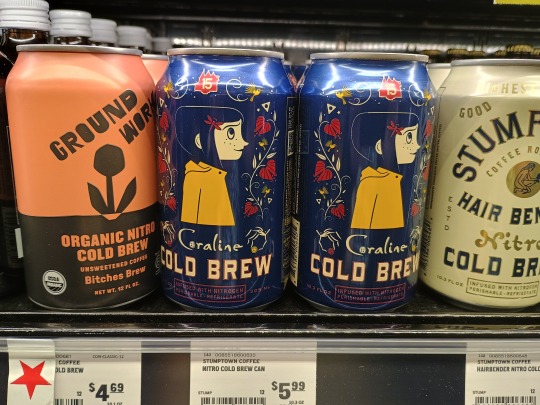
Given that the video was just talking about Gaiman being more a brand than an author I took this as a sign to share my two cents.
The cents are these: beyond considerations of fandom, parasocial attachment, Death of the Author and capitalism, which the video covers admirably*, can we posit that the art you find yourself the most attracted to as a teenager might not be stuff you should be buying as an adult?
*(they do quote an Alan Moore article from The Fucking Guardian in which he says he hates the growing trend of treating authors as "part of the costumed entertainment" without pointing out that the man wears a costume at all times, which is part of his branding, just like Gaiman. Also maybe given the company he keeps we should start asking more questions about Lost Girls. But I digress.)
Do you want to live in the moral universe of C.S. Lewis? J.D. Salinger? J.K. Rowling? J.R.R. Tolkien? (Maybe going by one's initials is the problem here, actually.) A grown person who thinks for a living shouldn't be going around saying that Neil Gaiman is one of their heroes. Even if you like his books, you've got to admit that the dude's mostly style and reference, that his actual insights don't go beyond those of a bright teenager. It's commodified rebellion for rebellion fans, sitting on the shelf next to Rowling's commodified conformity for conformity fans. We can still have fun with pop but we have to understand that the people who make it are in the sales business. (Yes, even Kendrick.)
The reason this stuff is constantly sold back to you is that it's really easy to sell things to children. The less like a child you become, the harder it is to market to you, so it's in the interests of money to draw you back to your childhood in a million different ways. So: grow up and get some esoteric, contradictory tastes, just to fuck with them. Cut out the hero worship - don't respect people for their "talent" any more than you would respect them for being rich. This will make you less likely to be starstruck enough to follow around a third-rate tumblr daddy dom who thinks he's a wizard.
(no, not me)
Finally, because I'm also a leftist, here's the overlong and self-satisfied part. I read a lot of Gaiman in high school but I also read a lot of one of Gaiman's heroes, Harlan Ellison. He was my favorite! I liked him because he was stylish, aggressive, arrogant and brutal. Teenagers like power and he had it. The fact that none of his stories had real people in them and that he seemed to have a problem with women in particular was nothing to me in the face of his Muscular Prose. Then I went to college and met some people who were smarter than me.
I ended up dumping Ellison for what was in his work, long before I knew much about all the other stuff. Same thing with Gaiman. So if you're worried about being let down by one of your heroes, I suggest looking at all of them carefully. Particularly at their feet. (Not for horny reasons.) And then maybe stop looking at them at all and go do something else.
55 notes
·
View notes
Text
Milton Orr looked across the rolling hills in northeast Tennessee. ��I remember when we had over 1,000 dairy farms in this county. Now we have less than 40,�� Orr, an agriculture adviser for Greene County, Tennessee, told me with a tinge of sadness.
That was six years ago. Today, only 14 dairy farms remain in Greene County, and there are only 125 dairy farms in all of Tennessee. Across the country, the dairy industry is seeing the same trend: In 1970, more than 648,000 US dairy farms milked cattle. By 2022, only 24,470 dairy farms were in operation.
While the number of dairy farms has fallen, the average herd size—the number of cows per farm—has been rising. Today, more than 60 percent of all milk production occurs on farms with more than 2,500 cows.

This massive consolidation in dairy farming has an impact on rural communities. It also makes it more difficult for consumers to know where their food comes from and how it’s produced.
As a dairy specialist at the University of Tennessee, I’m constantly asked: Why are dairies going out of business? Well, like our friends’ Facebook relationship status, it’s complicated.
The Problem with Pricing
The biggest complication is how dairy farmers are paid for the products they produce.
In 1937, the Federal Milk Marketing Orders, or FMMO, were established under the Agricultural Marketing Agreement Act. The purpose of these orders was to set a monthly, uniform minimum price for milk based on its end use and to ensure that farmers were paid accurately and in a timely manner.
Farmers were paid based on how the milk they harvested was used, and that’s still how it works today.
Does it become bottled milk? That’s Class 1 price. Yogurt? Class 2 price. Cheddar cheese? Class 3 price. Butter or powdered dry milk? Class 4. Traditionally, Class 1 receives the highest price.
There are 11 FMMOs that divide up the country. The Florida, Southeast, and Appalachian FMMOs focus heavily on Class 1, or bottled, milk. The other FMMOs, such as Upper Midwest and Pacific Northwest, have more manufactured products such as cheese and butter.
For the past several decades, farmers have generally received the minimum price. Improvements in milk quality, milk production, transportation, refrigeration, and processing all led to greater quantities of milk, greater shelf life, and greater access to products across the US. Growing supply reduced competition among processing plants and reduced overall prices.
Along with these improvements in production came increased costs of production, such as cattle feed, farm labor, veterinary care, fuel, and equipment costs.
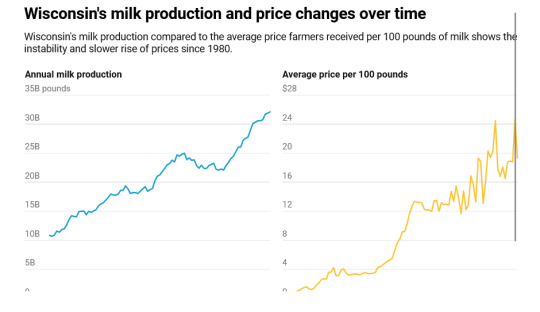
Researchers at the University of Tennessee in 2022 compared the price received for milk across regions against the primary costs of production: feed and labor. The results show why farms are struggling.
From 2005 to 2020, milk sales income per 100 pounds of milk produced ranged from $11.54 to $29.80, with an average price of $18.57. For that same period, the total costs to produce 100 pounds of milk ranged from $11.27 to $43.88, with an average cost of $25.80.
On average, that meant a single cow that produced 24,000 pounds of milk brought in about $4,457. Yet, it cost $6,192 to produce that milk, meaning a loss for the dairy farmer.
More efficient farms are able to reduce their costs of production by improving cow health, reproductive performance, and feed-to-milk conversion ratios. Larger farms or groups of farmers—cooperatives such as Dairy Farmers of America—may also be able to take advantage of forward contracting on grain and future milk prices. Investments in precision technologies such as robotic milking systems, rotary parlors, and wearable health and reproductive technologies can help reduce labor costs across farms.
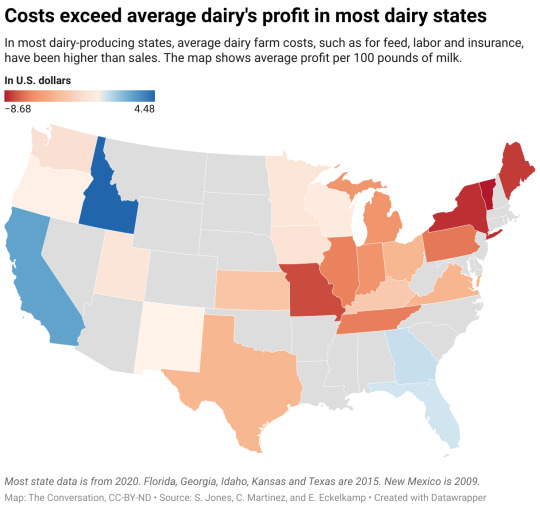
Regardless of size, surviving in the dairy industry takes passion, dedication, and careful business management.
Some regions have had greater losses than others, which largely ties back to how farmers are paid, meaning the classes of milk, and the rising costs of production in their area. There are some insurance and hedging programs that can help farmers offset high costs of production or unexpected drops in price. If farmers take advantage of them, data shows they can functions as a safety net, but they don’t fix the underlying problem of costs exceeding income.
Passing the Torch to Future Farmers
Why do some dairy farmers still persist, despite low milk prices and high costs of production?
For many farmers, the answer is because it is a family business and a part of their heritage. Ninety-seven percent of US dairy farms are family owned and operated.
Some have grown large to survive. For many others, transitioning to the next generation is a major hurdle.
The average age of all farmers in the 2022 Census of Agriculture was 58.1. Only 9 percent were considered “young farmers,” age 34 or younger. These trends are also reflected in the dairy world. Yet, only 53 percent of all producers said they were actively engaged in estate or succession planning, meaning they had at least identified a successor.
How to Help Family Dairy Farms Thrive
In theory, buying more dairy would drive up the market value of those products and influence the price producers receive for their milk. Society has actually done that. Dairy consumption has never been higher. But the way people consume dairy has changed.
Americans eat a lot, and I mean a lot, of cheese. We also consume a good amount of ice cream, yogurt, and butter, but not as much milk as we used to.
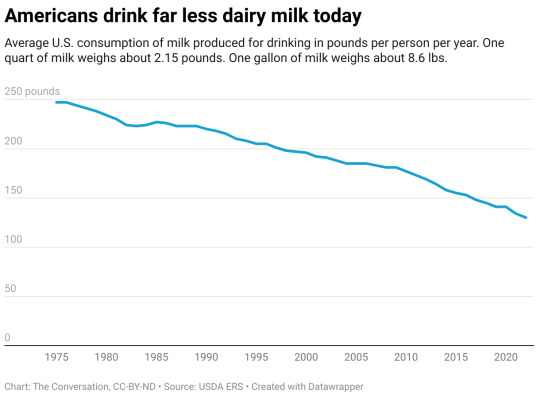
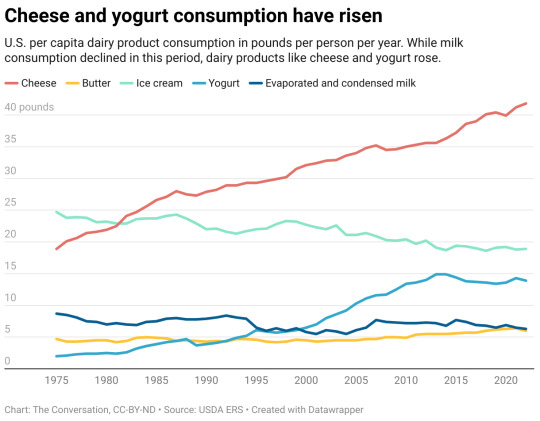
Does this mean the US should change the way milk is priced? Maybe.
The FMMO is currently undergoing reform, which may help stem the tide of dairy farmers exiting. The reform focuses on being more reflective of modern cows’ ability to produce greater fat and protein amounts; updating the cost support processors receive for cheese, butter, nonfat dry milk, and dried whey; and updating the way Class 1 is valued, among other changes. In theory, these changes would put milk pricing in line with the cost of production across the country.
The US Department of Agriculture is also providing support for four Dairy Business Innovation Initiatives to help dairy farmers find ways to keep their operations going for future generations through grants, research support, and technical assistance.
Another way to boost local dairies is to buy directly from a farmer. Value-added or farmstead dairy operations that make and sell milk and products such as cheese straight to customers have been growing. These operations come with financial risks for the farmer, however. Being responsible for milking, processing, and marketing your milk takes the already big job of milk production and adds two more jobs on top of it. And customers have to be financially able to pay a higher price for the product and be willing to travel to get it.
33 notes
·
View notes
Text
Fine Fragrances Are Getting a New Gourmet Twist
Distinct from “gourmand” fragrances that favour food notes of vanilla or almond, “neo-gourmand” fragrances are more sophisticated and sculptural.
As fragrance enjoys a post-pandemic boom, mass retailers and niche brands are hopping on the trend producing new and experimental olfactive takes on milks, fruits, nuts and other pantry staples.
Founders and fragranciers say neo-gourmands are both nostalgic and novel, able to evoke the pleasure of food and the comfort of memory while also having an “addictive” quality.
Read the rest of the article under the cut
Beauty shoppers have never been more ravenous for foodlike fragrances. Generally sweet and historically marketed to young women or adolescents, scents that feature edible notes like vanilla, chocolate or coconut are lately one of the most popular categories in the fragrance industry, where they’re known as “gourmands.” But a new batch of scents, referred to by perfumers and retailers as “neo-gourmands,” are taking the concept into more sophisticated and offbeat territory. Some are built around unexpected notes, like sesame or sea salt, while others add woody, smoky or contrasting notes to produce new and unusual scent cocktails.
Neo-gourmands are “hitting everywhere, from a trickle-up, trickle-down perspective,” said Mary Testa-Gough, associate vice president of product and fragrance development at Bath and Body Works. The mall brand recently launched a new scent for the holidays called Perfect in Pink, with a signature note based on a fictional fruit — the Yum-Yum cherry — created with the Swiss flavour and fragrance corporation Givaudan and nosed by Louise Turner, whose portfolio also includes Carolina Herrera’s Good Girl.
Neo-gourmands are helping to drive the red-hot fragrance market, one of the fastest-growing segments in beauty this year with sales up 14 percent in the third quarter, according to data from Circana, driven in large part by a tilt toward the luxury market. In its most recent earnings report, Bath and Body Works upped its sales expectations for the fourth quarter of 2024, driven in part by holiday demand for its premiumised scents like Perfect in Pink.
The food-focused fragrances also offer a way into a more mainstream category for niche brands like D.S. & Durga and By Kilian. Gourmand scents can be thought of as twee or unsophisticated, and for brands that market themselves to connoisseurs, a super-sweet, cherry-laden perfume might not fit the bill. On the other hand, an accord of red fruit, leather and salt just might.
Upmarket retailer Bluemercury has a dedicated assortment of neo-gourmands centred on “dark vanilla,” combined with leathers or ambers. Best-sellers include BDK Parfums Velvet Tonka ($230) and Tom Ford Tobacco Vanille ($300). While vanilla is far and away the most popular hook, Gatlin Chambers, a merchant assistant with the retailer, has also noticed marked interest in fruits, marshmallows and pistachios.
The resurgence of gourmand fragrances relies on the earthly magic of nostalgia. Just as trends from the 1990s and 2000s like low-rise jeans and pochette It-bags have reappeared in fashion, similar ripples are moving through the beauty industry. Some of the most enduring gourmands, like Thierry Mugler’s Angel, a blend of fruit, chocolate and vanilla, were minted in that era.
For Rosie Johnston, a makeup artist turned perfumer, the current popularity of gourmands reminds her of the Los Angeles she moved to in the ‘90s. “Even though there was that grunge era, and the whole Nirvana movement, all of that, people were wearing vanilla essential oil,” Johnston said. “It was, like, a sweet kind of dirty.”
Johnston founded a clean fine-fragrance label, called By Rosie Jane, in 2012, and released a scent called Dulce in 2022. “I think we were all craving the same thing. We all went through Covid.” She wanted Dulce “to be reminiscent of a time that felt a little easier, a little more close and connected.”
The minimalist label Commodity’s best-seller is called Milk, but made with sesame oil. The result “gives a sense of familiarity without being precisely identifiable,” according to Vicken Arslanian, the founder and chief executive of Europarfums, the US-based fragrance portfolio that acquired Commodity in 2019. Arslanian added that the scent accounts for about 60 percent of the brand’s sales. “You’re getting the clarity of the classic singular gourmand notes with the esoteric experimentation of the artistic fragrances,” Arslanian said.
Tapping into the trend doesn’t necessarily mean entirely new formulations. Legacy brands like Lancôme and Dolce & Gabbana have been reworking their hero scents with a neo-gourmand twist. Lancôme’s Idôle Nectar, introduced in 2022, features notes of vanilla, caramel and popcorn, while Dolce & Gabbana launched an intense version of its Devotion fragrance this year that opens with a hazelnut pop (and is based in vanilla). Mugler recently expanded its decades-old Angel line with Fantasm, which blends the original with dollops of creamy piña colada.
In September, Glossier released the first two extensions of its best-selling scent You, one made with musk and wood and the other with plum and buttercream. The latter, You Rêve, has polarised fans of the original scent. “The warm plum scent is lipsticky — almost plasticky — in a super cool, nostalgic way,” one Fragrantica user wrote. Another likened it to “cherry chapstick.”
“A lot of times we’re using these notes to create something addictive,” said Frank Voelkl, the perfumer at fragrance house DSM-Firmenich responsible for the new You. The term comes up constantly in describing neo-gourmands, which “still want to be sweet and addictive, but also want to be a bit more elevated,” Moda Operandi’s beauty director Jessica Matlin recently told Allure. They want customers coming back for repeat sniffs.
More experiments in foodie scents are coming down the pipeline. In January, Shiseido will officially unveil Le Sel d’Issey, Issey Miyake’s interpretation of a sea-salt fragrance, and the last one the Japanese designer worked on before his passing in 2022. The brand hopes to capture the hearts and noses of young male customers. Also in January, Parfums Christian will introduce Bois Talisman, a vanilla-forward scent inspired by sugar cubes and cedarwood that “invents its own expressive realm, of immediate and universal addiction,” wrote Francis Kurkdjian, Dior’s nose and “Creation Director.”
“I think these flavourful, tasty textures are probably a little bit what you call the ‘new gourmand.’” Voelkl added. “It’s more complex, it’s more faceted. It goes way beyond being just sweet.”
2 notes
·
View notes
Text



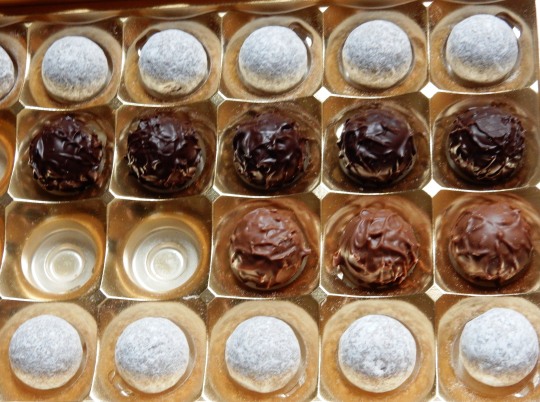












International Chocolate Day
While there may be a few people in the world who don’t like chocolate, for most of the world chocolate is considered to be a delicious treat. And for some people, chocolate may even be considered an obsession.
International Chocolate Day was created to learn about, celebrate and enjoy everything that has to do with chocolate!
History of International Chocolate Day
Chocolate plants have probably been on earth since the dawn of history. But it wasn’t until around 4000 years ago that the Olmec people of Mesoamerica (present day Mexico) began turning cocoa beans into a beverage. At the time, drinking chocolate was a rather rare and special delicacy that was used in cultural rituals as well as for medicinal purposes.
When the Aztecs and Mayans got involved with it years later, cocoa beans eventually were cultivated and used as valuable currency for trading. Mayans even referred to chocolate as a “drink from the gods”, and the Aztecs considered it to be an important way to prepare for war as well as using it as an aphrodisiac.
Around the 16th century, chocolate made its way to Europe, although the Spanish kept it a secret for quite some time. Eventually, “chocolate houses” (something like a pub but for chocolate) began popping up in Britain and the trend spread through Europe.
The invention of the chocolate press influenced chocolate making and made the possibility of solid chocolates more feasible. In addition, the Dutch process to make cocoa powder allowed chocolate to be more accessible to more people, other than just the rich or royals.
By the mid-to-late-1800s, chocolate companies began manufacturing chocolate bars in Europe. Nestle, J.S. Fry and Sons and Lindt companies were all started during this time. Later, other companies came along such as Hershey’s, Cadbury, Mars and more.
As the processes of making chocolate have been refined over the years and access to sugar and other ingredients has become easier, chocolate has become part of everyday life for many people.
Recipes that call for the ingredient might include chocolate candies, cakes, brownies, cookies, cupcakes and so much more. And it can be used in the form of cocoa powder or baking chocolate in dark, semi-sweet or milk chocolate versions.
International Chocolate Day is about paying heed to everything related to this delightful treat that is now part of cultures all over the world. Enjoy learning about and taking part in the celebration of this day!
International Chocolate Day Timeline
2000 BC Cacao beans used in Mesoamerica
Ancient Olmec people in what is modern-day Mexico turn the beans into a chocolate drink and use it medicinally.
600 AD Mayan people begin cultivating cocoa
Understanding the great value of this plant, the Mayans begin growing cocoa beans on farms.
15th Century Aztecs use cocoa as currency
So precious were these beans, the Aztec people found them a convenient and valuable way to secure trade.
1875 First milk chocolate hits the market
Daniel Peter introduces milk chocolate in Switzerland.
1894 Hershey Chocolate Company is started
One of the most famous American chocolate companies, Hershey gets its start in Pennsylvania.
How to Celebrate International Chocolate Day
A favorite day of the year for many people, International Chocolate Day is certainly one that deserves celebrating. Consider some of these ideas for participating in and enjoying this day:
Enjoy Eating Some Chocolate
Whether it’s milk chocolate, semi-sweet chocolate or dark chocolate, International Chocolate Day is the perfect time to enjoy taking part in this delicious treat. Grab a favorite type of chocolate bar, like Hershey’s, Nestle or Ghirardelli, or try out some new and special types of chocolate that are sourced from different parts of the world.
Another fun way to celebrate the day is to buy a huge box of chocolates and try out the different flavors. Whitman’s Samplers, Fannie May, Richart, Lindt and Godiva are just a few of the companies that make assorted boxes of chocolates. Read the list on the lid to find out what you are eating, or hide the list and make a guessing game out of finding out which flavor each chocolate is!
Host an International Chocolate Day Event
Whether it’s a setup in the breakroom with coworkers at the office or a party at home including neighbors and friends, International Chocolate Day is a great time to gather chocolate lovers together and pay heed to this worldwide sensation.
Featuring everything chocolate, this gathering can include creative snacks like a chocolate fountain, homemade chocolate brownies or chocolate ice cream sundaes. For activities, try a chocolate tasting table where guests can sample a variety of chocolates that are sourced from around the world. Perhaps include chocolates that contain higher or lower percentages of cocoa.
Enjoy Chocolate For All the Meals
Chocolate doesn’t have to be only for dessert! It can be used in savory meals as well. So, in honor of International Chocolate Day, in addition to having it for a snack or dessert, try including chocolate in meals for breakfast, lunch and dinner.
Chocolate for breakfast can be an easy inclusion. Chocolate yogurt, chocolate smoothies, or chocolate cherry muffins can be on the menu. If the chocolate included in breakfast is dark chocolate, it can even work in a healthy manner to help to burn body fat and decrease blood sugar levels throughout the day!
For lunch and dinner, savory meals can be created that include chocolate. Certain recipes for chili (specially Cincinnati style chili) include shavings of dark chocolate and cinnamon flavors and it’s served on top of pastas. Mole sauce, which is a traditional Mexican dish, is made with chocolate and spices and used on meat dishes, tortillas, or enchiladas.
Salads make a great light lunch and many salad recipes can be adjusted to incorporate some chocolate. Try a spinach pear salad with chocolate vinaigrette or a baby spinach and strawberry salad with vidalia onions and cacao nibs.
Bake Something with Chocolate
Of course, the easiest time to incorporate chocolate into eating is for dessert. Try whipping up a basic brownie recipe, baking some pre-made chocolate chip cookie dough, or preparing some easy no-bake chocolate, peanut butter and oat cookies without even having to turn the oven on. International Chocolate Day is a great time to enjoy baking with this versatile ingredient.
Share Chocolate with Friends
As long as you are cooking or baking, why not go ahead and share with someone special in celebration of the day? Or, for those who don’t feel like baking, feel free to pop over to a local bakery or grocery store! Box up some chocolate cupcakes to give to the neighbors, pass out some chocolate muffins at work or simply get a big chocolate bar and share it with the family!
International Chocolate Day FAQs
Can chocolate kill dogs?
Some properties in chocolate can be toxic. It may be poisonous to dogs depending on their size and how much they consume.
Does chocolate cause constipation?
Chocolate can slow down the digestive process and is one of the worst causes of constipation.
Did chocolate come from the New World?
Yes, chocolate originated in the New World and was brought back to Spain in the 16th century.
Does chocolate have caffeine?
Chocolate does have caffeine. The darker the chocolate is, the higher the caffeine content is.
Does chocolate cause acne?
While there is no evidence that chocolate causes acne, some people find anecdotal evidence that their skin condition is negatively impacted.
Source
#International Chocolate Day#original photography#food#snack#Chocolat Frey#Lindt CONNAISSEURS#Lindt & Sprüngli#Lindt TRUFFES#Sprüngli#truffles#Lindt PRALINÉS DU CONFISEUR#Swiss chocolate is the best#I only eat Swiss chocolate#InternationalChocolateDay#13 September#pralines#box of chocolate
2 notes
·
View notes
Text
Dairy Ingredients Market: Navigating Challenges and Opportunities
The dairy ingredients market has experienced significant growth over the past few years, driven by an increasing global demand for functional and nutrient-rich foods. Dairy ingredients, such as milk powders, whey protein, casein, and lactose, are essential components in a variety of food and beverage products, nutritional supplements, and even pharmaceuticals. As consumer preferences evolve and new innovations emerge, the future outlook for the dairy ingredients market looks promising, with several key trends shaping its development.
1. Growing Demand for Protein-Rich Products
One of the most notable trends in the dairy ingredients market is the rising demand for protein-enriched foods. With consumers becoming more health-conscious and focusing on fitness and wellness, there has been a surge in demand for high-protein dairy ingredients, particularly whey protein. This ingredient, widely used in sports nutrition, weight management products, and functional foods, is expected to continue growing as people seek to improve their health and build muscle mass. Whey protein isolates, concentrates, and hydrolysates are popular choices among consumers looking for convenient protein sources.
In addition, the popularity of plant-based diets has spurred the development of dairy-based protein alternatives. The growth of dairy-free products, particularly in beverages, is fueling demand for dairy ingredients that can mimic the texture and taste of traditional dairy products.
2. Innovation in Product Offerings

Additionally, there is increased interest in fortified dairy products that offer added benefits such as probiotics, prebiotics, and vitamins. These functional ingredients are being used to support digestive health, immunity, and overall well-being, creating new opportunities in the dairy ingredients market.
Manufacturers are also exploring the potential of dairy ingredients in non-food industries, including cosmetics and pharmaceuticals. Dairy-based proteins and other bioactive compounds are being researched for their benefits in skincare and wound healing. The growing interest in these cross-industry applications opens up new avenues for dairy ingredient manufacturers to diversify their offerings.
3. Sustainability and Clean Label Demand
Sustainability has become a driving force in many industries, and the dairy ingredients market is no exception. Consumers are increasingly concerned with the environmental impact of the products they purchase, and there is growing demand for products that are sustainably sourced and produced. As a result, dairy ingredient manufacturers are adopting more eco-friendly practices, such as reducing water and energy usage in production processes, minimizing packaging waste, and sourcing ingredients from environmentally responsible farms.
The clean label trend, where consumers prefer products with simple, transparent ingredient lists, is also influencing the dairy ingredients market. Manufacturers are responding by offering dairy ingredients that are minimally processed, free from artificial additives, and aligned with consumer preferences for natural and wholesome products. This shift toward transparency and sustainability will likely continue to shape the dairy ingredients market in the coming years.
4. Expansion in Emerging Markets
Emerging markets, particularly in Asia-Pacific, Latin America, and Africa, are poised to be key growth areas for the dairy ingredients market. As incomes rise and access to dairy products increases in these regions, demand for dairy ingredients, particularly milk powders and whey proteins, is expected to grow significantly. In many developing countries, dairy ingredients are used in a variety of products, including infant formulas, processed foods, and beverages.
The increasing urbanization and changes in dietary habits in emerging markets are driving the need for convenience and fortified food products, which often rely on dairy ingredients. Manufacturers looking to tap into these growing markets must adapt their products to suit local tastes, preferences, and nutritional needs.
5. Technological Advancements in Dairy Processing
Technological advancements in dairy processing are playing a significant role in shaping the future of the dairy ingredients market. Innovations such as membrane filtration, enzyme technology, and ultra-filtration are improving the efficiency and quality of dairy ingredient production. These advancements enable manufacturers to extract more protein from milk, enhance product yields, and create new ingredients that offer superior functional properties.
Additionally, the adoption of digital technologies, such as blockchain, is improving traceability and transparency in the supply chain, which is crucial for ensuring product quality and meeting consumer demand for sustainably sourced ingredients. As dairy ingredient manufacturers embrace these technologies, they can enhance their operations and provide consumers with higher-quality, more sustainable products.
6. Regulatory and Market Challenges
Despite the optimistic outlook for the dairy ingredients market, there are several challenges that manufacturers will need to navigate. Regulatory hurdles, particularly concerning food safety standards and labeling requirements, may vary by region, requiring companies to stay up-to-date with local regulations. Moreover, fluctuations in milk prices, due to factors such as weather conditions, animal health, and feed costs, can impact the profitability of dairy ingredient manufacturers.
Additionally, the dairy industry faces competition from plant-based alternatives, which are gaining traction in many markets due to concerns over health, ethics, and the environment. While dairy ingredients remain a crucial part of the global food system, the rise of plant-based proteins and the growing popularity of dairy-free products pose potential threats to traditional dairy markets.
Conclusion
The future of the dairy ingredients market looks bright, with numerous growth opportunities driven by changing consumer preferences, innovations in product development, sustainability efforts, and emerging markets. While challenges such as regulatory compliance, raw material pricing, and competition from plant-based alternatives remain, dairy ingredient manufacturers that adapt to these trends and embrace new technologies will be well-positioned for success. The industry’s focus on health, sustainability, and innovation will continue to shape its evolution in the coming years, opening up new possibilities for manufacturers and consumers alike.
As the dairy ingredients market continues to evolve, businesses that focus on meeting consumer demands for protein-rich, functional, and sustainable products will lead the charge toward a prosperous future.
Get Free Sample and ToC : https://www.pristinemarketinsights.com/get-free-sample-and-toc?rprtdtid=NDc4&RD=Dairy-Ingredients-Market-Report
0 notes
Text
How to Make Blue Tea Ice Cream at Home: A Sweet Fusion of Health and Flavor
As the scorching summer sun blazes over India, a refreshing bowl of ice cream can be the perfect way to cool off. But what if we told you that this indulgence could also be infused with health benefits? Enter blue tea ice cream—a visually stunning and antioxidant-rich treat that’s captivating the taste buds of food enthusiasts and health-conscious individuals alike. With its unique hue derived from the butterfly pea flower, blue tea ice cream is the latest trend that seamlessly blends wellness and indulgence.
In this guide, we’ll explore how you can create this delicious dessert at home, even if you’re on a budget. Plus, we’ll share insights from culinary experts and touch upon trending businesses under ₹1 lakh in India—a keyword relevant to our entrepreneurial audience.
Why Blue Tea Ice Cream?
Blue tea, made from butterfly pea flowers, is celebrated for its myriad health benefits, including reducing stress, enhancing skin health, and boosting brain function. Pairing this superfood with ice cream not only results in a stunning dessert but also adds a healthy twist to your favorite treat.
Ingredients You Need
Before diving into the process, gather these simple ingredients:
Butterfly pea flowers (dried): 10-15 flowers
Milk: 2 cups
Heavy cream: 1 cup
Sugar: ½ cup
Vanilla extract: 1 teaspoon
Cornstarch: 1 tablespoon (optional, for thickening)
Lemon juice: A few drops (for a color change effect)
Ice cream maker (optional)
Step-by-Step Recipe
1. Brew the Blue Tea
In a saucepan, boil 1 cup of water and add the dried butterfly pea flowers.
Let it steep for 5-7 minutes until the water turns a vibrant blue.
Strain and set aside the tea to cool.
2. Prepare the Ice Cream Base
In another saucepan, heat the milk, cream, and sugar over medium heat.
Stir continuously until the sugar dissolves completely.
If you prefer a thicker consistency, mix the cornstarch with a little cold milk and add it to the saucepan. Cook for another 2-3 minutes.
3. Combine the Ingredients
Once the milk mixture has cooled, add the brewed blue tea and vanilla extract.
Stir well to ensure the color and flavors are evenly distributed.
4. Optional Magic with Lemon Juice
For a fun twist, add a few drops of lemon juice. This will change the blue hue to a purple tone, adding a delightful visual element.
5. Freeze and Churn
Pour the mixture into an ice cream maker and churn according to the manufacturer’s instructions.
If you don’t have an ice cream maker, pour the mixture into a container, cover it, and freeze. Stir it every 30 minutes for the first 4 hours to break up ice crystals.
6. Serve and Enjoy
Scoop the ice cream into bowls or cones and garnish with edible flowers for an Instagram-worthy presentation.
Expert Insights on Blue Tea Ice Cream
We spoke to culinary expert Chef Ananya Rao, who shared, “Blue tea ice cream is not just a dessert; it’s an experience. Its natural color and health benefits make it a standout choice for those looking to innovate in the kitchen.”
Top Wedding Photography Trends in India: A Parallel Connection
Interestingly, blue tea ice cream aligns with the current trend of uniqueness and personalization seen in top wedding photography trends in India. Couples today seek unconventional and vibrant themes—much like the charm of this dessert. Incorporating blue tea ice cream into wedding menus is a creative way to match the vibrancy of these trends.
Business Opportunity: Best Businesses Under ₹1 Lakh
If you’re an entrepreneur inspired by this trend, starting a homemade blue tea ice cream business could be a lucrative venture. With an initial investment under ₹1 lakh, you can source organic ingredients, invest in packaging, and market through social media to tap into India’s growing demand for artisanal and health-focused desserts.
Tips for Success
Local Sourcing: Collaborate with local farmers for fresh butterfly pea flowers and dairy products.
Packaging: Use eco-friendly and visually appealing packaging to stand out.
Marketing: Leverage Instagram reels and YouTube shorts to showcase the vibrant process of making blue tea ice cream.
FAQs
Q: Can I make this recipe vegan?A: Absolutely! Replace milk and heavy cream with coconut milk or almond milk for a dairy-free version.
Q: Where can I buy butterfly pea flowers?A: They’re available online or at specialty stores selling organic or herbal products.
Q: How long does homemade ice cream last?A: Store it in an airtight container in the freezer for up to 2 weeks.
Special Offer for Aspiring Entrepreneurs
If you’re considering starting a business, here’s a limited-time offer: Attend our free webinar on “Turning Small Investments into Big Profits” and learn how to build a successful business under ₹1 lakh. Register now to secure your spot!
Conclusion
Blue tea ice cream is more than a dessert—it’s a conversation starter, a health booster, and a business opportunity waiting to be explored. Whether you’re a bride planning a unique wedding menu, an entrepreneur seeking new ventures, or a student experimenting in the kitchen, this recipe is your gateway to something extraordinary. Dive in and create magic with every scoop!
0 notes
Text
Beverage Packaging Market: Rise of Reusable and Recyclable Packaging
The Beverage Packaging Market is a dynamic segment driven by the evolving consumer preferences for sustainability, convenience, and aesthetics. The increasing demand for both alcoholic and non-alcoholic beverages globally fuels growth, while innovations in packaging materials and formats contribute to market expansion.
Read Complete Report Details of Beverage Packaging Market: https://www.snsinsider.com/reports/beverage-packaging-market-2871
Market Segmentation
By Material
Plastic
Description: Includes PET, HDPE, and other polymers.
Growth Drivers: Lightweight, cost-effective, and versatile.
Trends: Rising adoption of recycled and biodegradable plastics.
Metal
Description: Aluminum and steel are the key materials used.
Growth Drivers: High durability and recyclability.
Trends: Preference for cans in carbonated and alcoholic beverages.
Glass
Description: A premium and sustainable packaging material.
Growth Drivers: Non-toxic, inert, and suitable for premium beverages.
Trends: Increasing use in wine, spirits, and specialty drinks.
By Product Type
Bottles
Widely used for alcoholic and non-alcoholic beverages.
Focus on lightweight glass and PET bottles.
Cans
Popular for carbonated drinks, energy drinks, and beer.
Growing adoption of resealable aluminum cans.
Cartons
Used for juices, milk, and plant-based beverages.
Emphasis on eco-friendly aseptic packaging.
Pouches
Emerging format for ready-to-drink and single-serve products.
Focus on resealable and recyclable designs.
Others
Includes tetra packs, kegs, and specialty packaging.
By Application
Alcoholic Beverages
Description: Includes beer, wine, and spirits.
Growth Drivers: Premiumization and demand for sustainable formats.
Trends: Lightweight glass bottles and aluminum cans.
Non-Alcoholic Beverages
Description: Comprises soft drinks, juices, bottled water, and sports drinks.
Growth Drivers: Health and wellness trends driving functional and plant-based drinks.
Trends: Increased use of eco-friendly and resealable packaging.
By Region
North America
Growth Drivers: High consumption of packaged beverages and focus on sustainability.
Trends: Growth in aluminum cans and recycled PET usage.
Europe
Growth Drivers: Stringent regulations on sustainable packaging and high demand for alcoholic beverages.
Trends: Adoption of lightweight glass and paper-based cartons.
Asia-Pacific
Growth Drivers: Rising urbanization, increasing disposable incomes, and growing preference for convenience.
Trends: High demand for single-serve and ready-to-drink formats.
Latin America
Growth Drivers: Expanding beverage market with focus on cost-effective packaging.
Trends: Preference for plastic bottles in the non-alcoholic segment.
Middle East & Africa
Growth Drivers: Growing beverage industry and increased investments in premium packaging.
Trends: Rising adoption of glass for premium and luxury beverages.
Market Trends and Opportunities
Sustainability Initiatives: Focus on biodegradable, recyclable, and reusable materials.
Technological Advancements: Smart packaging solutions like temperature-sensitive labels and QR codes.
Convenience Packaging: Increased demand for resealable, lightweight, and portable formats.
Aesthetic Appeal: Innovative designs and customization to attract consumer attention.
Market Outlook
The Beverage Packaging Market is poised for steady growth through 2032, with sustainability and innovation shaping its trajectory. Asia-Pacific is expected to dominate, followed by North America and Europe, as consumer demand for environmentally friendly and functional packaging formats continues to rise.
About Us:
SNS Insider is a global leader in market research and consulting, shaping the future of the industry. Our mission is to empower clients with the insights they need to thrive in dynamic environments. Utilizing advanced methodologies such as surveys, video interviews, and focus groups, we provide up-to-date, accurate market intelligence and consumer insights, ensuring you make confident, informed decisions.
Contact Us:
Akash Anand – Head of Business Development & Strategy
Phone: +1-415-230-0044 (US) | +91-7798602273 (IND)
0 notes
Text
Feed Mycotoxin Binders and Modifiers Market
Feed Mycotoxin Binders and Modifiers Market Size, Share, Trends: Cargill, Inc. Leads
Rising adoption of natural and organic mycotoxin binders in animal feed drives market growth.
Market Overview:
The Feed Mycotoxin Binders and Modifiers Market is projected to grow at a CAGR of 4.7% from 2024 to 2031. The market value is expected to increase significantly during this period. Europe currently dominates the market, with key metrics including increasing awareness about animal health, stringent regulations on feed safety, and rising demand for quality animal products. The market is experiencing steady growth driven by the growing prevalence of mycotoxin contamination in animal feed, increasing livestock production, and advancements in mycotoxin binding technologies.
The feed mycotoxin binders and modifiers market is rapidly turning towards natural and organic solutions. This trend is being driven by increased consumer demand for organic animal products and growing concerns about the use of synthetic substances in animal feed. Natural binders, such as yeast cell walls, algae-based products, and plant extracts, are becoming increasingly popular because they successfully bind mycotoxins while leaving no harmful residues in animal products. For example, a recent study published in the Journal of Animal Science discovered that yeast cell wall-based binders can reduce aflatoxin contamination in dairy cow milk by up to 60%. In some countries, legislation governing the use of chemical additives in animal feed are being tightened, which is contributing to this development. As a result, several feed companies are reformulating their products to include natural mycotoxin binders, which is driving market expansion in this category.
DOWNLOAD FREE SAMPLE
Market Trends:
The feed mycotoxin binders and modifiers market is rapidly turning towards natural and organic solutions. This trend is being driven by increased consumer demand for organic animal products and growing concerns about the use of synthetic substances in animal feed. Natural binders, such as yeast cell walls, algae-based products, and plant extracts, are becoming increasingly popular because they successfully bind mycotoxins while leaving no harmful residues in animal products. For example, a recent study published in the Journal of Animal Science discovered that yeast cell wall-based binders can reduce aflatoxin contamination in dairy cow milk by up to 60%. In some countries, legislation governing the use of chemical additives in animal feed are being tightened, which is contributing to this development. As a result, several feed companies are reformulating their products to include natural mycotoxin binders, which is driving market expansion in this category.
Market Segmentation:
Mycotoxin binders, particularly those based on clay minerals and yeast cell walls, have emerged as the market leader in the feed mycotoxin binders and modifiers category. These products work by adsorbing mycotoxins in animals' gastrointestinal tracts, preventing absorption and its detrimental consequences. Binders' dominance may be attributed to their broad-spectrum efficacy against a variety of mycotoxins, simplicity of incorporation into animal feed, and low cost when compared to other mitigation strategies.
Numerous scientific studies have proved the efficacy of mycotoxin binders. For example, a recent meta-analysis published in the Journal of Dairy Science discovered that employing mycotoxin binders in dairy cattle feed resulted in a significant increase in milk yield and a reduction in aflatoxin M1 levels in milk. This level of evidence-based efficacy has led to the widespread usage of binders in the livestock industry.
Furthermore, regulatory support for binders has bolstered their market share. In 2019, the European Food Safety Authority (EFSA) approved particular bentonite clays as effective mycotoxin binders for all animal species, considerably increasing their use in the European market. This regulatory certification has increased farmer confidence in these items and encouraged feed manufacturers to include them in their recipes.
Market Key Players:
Cargill, Inc.
BASF SE
Alltech
Kemin Industries, Inc.
Novus International, Inc.
Biomin Holding GmbH
Contact Us:
Name: Hari Krishna
Email us: [email protected]
Website: https://aurorawaveintellects.com/
0 notes
Text
Soy Food Market
Soy Food Market Size, Share, Trends: Danone S.A. (Alpro) Leads
Rising Popularity of Innovative Soy-Based Meat Alternatives
Market Overview:
The global Soy Food Market is projected to grow at a CAGR of 6.8% from 2024 to 2031. The market size is expected to reach XX in 2024 and YY by 2031. Asia-Pacific dominates the market, accounting for approximately 45% of the global market share. Key metrics include increasing adoption of plant-based diets, growing awareness of soy's health benefits, and technological advancements in soy food processing.
The soy food market is expanding rapidly, driven by rising consumer demand for plant-based protein sources, increased health consciousness, and soy's adaptability in a variety of food applications. The shift towards vegetarian and vegan diets, particularly in developed economies, is accelerating market growth.
DOWNLOAD FREE SAMPLE
Market Dynamics:
The soy food industry is seeing a substantial movement towards novel meat substitutes that closely resemble the flavour, texture, and nutritional profile of animal-based products. This movement is being pushed by rising environmental concerns, animal welfare concerns, and a growing desire for sustainable protein sources.
According to a recent market survey, sales of soy-based meat replacements have increased by 35% in the last two years. A survey of 5,000 consumers from major marketplaces found that 60% had tried plant-based meat products, with soy-based ones being the most popular. Industry analysts project that by 2026, soy-based meat replacements may account for up to 20% of the entire soy food market value, thereby spurring significant innovation in product compositions and processing technology.
Market Segmentation:
Soy milk has emerged as the most popular segment in the soy food market due to its widespread acceptance as a dairy milk substitute, nutritional benefits, and versatility in a variety of uses. This segment's domination is due to an increasing number of lactose intolerant people and the growing popularity of plant-based diets.
Survey company indicates that the soy milk category will rise over the forecast period. A poll of 1,000 homes found that 40% buy soy milk on a regular basis, with 65% citing health benefits as their top motivation for doing so. The market is likely to maintain its lead until 2031.
Market Key Players:
Danone S.A. (Alpro)
The Hain Celestial Group, Inc.
Vitasoy International Holdings Limited
SunOpta Inc.
Impossible Foods Inc.
Tofurky
Contact Us:
Name: Hari Krishna
Email us: [email protected]
Website: https://aurorawaveintellects.com/
0 notes
Text
Coffee Machine Market: The Demand for Premium Coffee Makers
The coffee machine market has undergone significant transformation in recent years, driven by evolving consumer preferences, technological advancements, and a growing global coffee culture. As coffee consumption continues to rise across the world, so does the demand for innovative and convenient brewing solutions. The market for coffee machines has expanded, with a wide range of products that cater to different tastes, lifestyles, and budgets. In this article, we will explore some of the recent developments in the coffee machine industry and examine how these changes are shaping the future of the market.
Technological Advancements
One of the most significant developments in the coffee machine market is the integration of advanced technologies that improve both the brewing process and the overall user experience. For instance, many modern coffee machines now feature smart connectivity, allowing users to control their devices remotely through mobile apps or voice assistants like Amazon Alexa and Google Assistant. This allows coffee lovers to set brewing schedules, adjust brewing settings, and even receive notifications when their coffee is ready, all from the comfort of their smartphones.
Furthermore, advancements in heating technologies, such as precision temperature control and faster heat-up times, are also making a significant impact on the market. These innovations help achieve more consistent extraction, allowing consumers to enjoy barista-quality coffee at home with minimal effort. Some machines also offer customizable brewing options, letting users fine-tune the strength, temperature, and volume of their coffee, providing a personalized brewing experience.
Sustainability Focus
As sustainability becomes a growing concern for both consumers and manufacturers, many coffee machine brands have been adopting eco-friendly practices and focusing on reducing their environmental impact. The push towards sustainability is reflected in the materials used to make coffee machines, with companies opting for recyclable plastics, sustainable metal components, and energy-efficient designs.
Another area of sustainability focus is the reduction of single-use plastics. Many brands are now offering reusable filters, reducing the reliance on disposable pods or capsules that contribute to environmental waste. Some coffee machine manufacturers are even working to create fully biodegradable coffee pods, allowing consumers to enjoy the convenience of pod-based brewing without the guilt of harming the planet.
Increasing Demand for Specialty Coffee Machines
The growing interest in specialty coffee and the rise of the "coffee at home" trend have contributed to an increased demand for high-end, specialized coffee machines. Coffee aficionados are looking for machines that can brew gourmet coffee, such as espresso, cappuccinos, and lattes, with precision and ease. This demand for specialty machines has prompted manufacturers to introduce more advanced espresso machines, drip coffee makers, and capsule systems that cater to this premium market segment.
In response to this demand, coffee machine makers have been incorporating features that help elevate the brewing experience, such as built-in grinders for fresh coffee grounds, milk frothers, and automatic cleaning systems. This has made it easier for consumers to recreate café-style drinks at home, further boosting the market for premium machines.
E-Commerce and Online Sales Surge
The COVID-19 pandemic has had a lasting impact on the coffee machine market, with a notable shift toward online shopping and e-commerce platforms. As lockdowns and social distancing measures kept people at home, many consumers turned to online retailers for their coffee machine needs. This shift to e-commerce is expected to continue, with more brands focusing on improving their online presence and digital marketing strategies to capture this growing consumer base.
E-commerce platforms have made it easier for consumers to research, compare, and purchase coffee machines, with many offering detailed product reviews, customer ratings, and direct access to customer support. The convenience of online shopping, combined with fast delivery options, has further fueled the growth of the coffee machine market in recent years.
Market Expansion in Emerging Economies
While developed regions such as North America and Europe continue to lead the global coffee machine market, there has been a notable surge in demand from emerging economies in Asia-Pacific, Latin America, and the Middle East. As disposable incomes rise and urbanization increases, consumers in these regions are becoming more inclined to invest in coffee machines for their homes or offices. In particular, countries like China and India, which have historically not been major coffee-drinking nations, are now witnessing a growing interest in coffee culture, leading to a boom in coffee machine sales.
Conclusion
The coffee machine market is evolving rapidly, driven by technological advancements, sustainability initiatives, changing consumer preferences, and the rise of specialty coffee. As demand for high-quality, convenient brewing solutions continues to grow, manufacturers will need to innovate and adapt to meet the diverse needs of coffee lovers worldwide. With increased focus on sustainability, premium products, and the online shopping experience, the future of the coffee machine market looks bright.
0 notes
Text
Exploring the Surge in Demand for Dairy Products: A Comprehensive Analysis
In recent years, the dairy industry has experienced a significant transformation driven by evolving consumer preferences and sustainability initiatives. This shift has not only influenced global markets but also brought new opportunities and challenges to dairy producers worldwide. As consumers increasingly seek healthier, more sustainable food options, dairy producers are adapting to meet these demands through innovative practices and products.
Impact of Consumer Preferences on Dairy Production
The Dairy product news highlights a growing trend towards organic and free-range dairy products. This shift is largely influenced by consumer awareness regarding animal welfare and the environmental impact of dairy farming. Producers are now investing in more humane and eco-friendly farming techniques, which, while increasing operational costs, also allow them to cater to a niche market willing to pay a premium for sustainably produced dairy items.
Technological Advancements in Dairy Farming
The adoption of technology in dairy farming has revolutionized the industry. From robotic milking machines to advanced dairy management software, technology is making dairy farming more efficient and sustainable. These advancements not only improve the quality of dairy products but also enhance the overall productivity of dairy farms, enabling farmers to meet the increasing demand effectively.
Current Challenges Facing the Dairy Industry
Despite technological advancements and shifting consumer preferences, the dairy industry faces several challenges. These include fluctuating milk prices, trade disruptions, and the ongoing need to improve sustainability practices. Addressing these issues is crucial for the stability and growth of the dairy sector, ensuring that it can continue to thrive in a changing global marketplace.
Recent Developments in the Indian Dairy Sector
The latest dairy news from India reports significant growth and transformation in the sector. Indian dairy producers are increasingly focusing on product diversification and quality improvement to compete in both domestic and international markets. This includes the introduction of value-added products like flavored yogurts, cheese, and probiotic drinks that cater to the health-conscious consumer.
Future Prospects and Innovations in Dairy
Looking ahead, the dairy industry is poised for further innovation. Trends such as the development of lactose-free and high-protein dairy products are expected to drive growth. Additionally, the sector is likely to see increased collaboration between dairy farmers and tech companies to develop more sustainable and efficient dairy production methods.
Conclusion
As the dairy industry continues to evolve, staying informed with credible sources like dairynews7x7.com is essential for industry stakeholders to keep up with the latest trends and developments. This platform offers comprehensive coverage and insightful analyses, helping readers navigate the complexities of the dairy market effectively.
0 notes
Text
Sip into the Future: Trends Shaping the Non-Alcoholic Beverages Market
Download Sample : https://virtuemarketresearch.com/report/non-alcoholic-beverages-market/download-sample?utm_source=Medium&utm_medium=Blog&utm_campaign=Abhignya
🌍 The global non-alcoholic beverages market is booming! Valued at $1.4 trillion in 2023, it’s on track to reach $2.18 trillion by 2030. Wondering what’s behind this massive growth? Here’s a quick look at the trends and innovations shaking up your favorite drinks:
💧 Bottled Water Is the King With 40% of the market share, bottled water is the go-to choice for health-conscious consumers. Convenient, refreshing, and calorie-free—what’s not to love?
🍹 Functional Beverages Are the New Cool Say hello to drinks that do more than quench your thirst! Functional beverages packed with probiotics, vitamins, and minerals are trending big. Think gut health, immunity boosters, and energy enhancers—all in one sip.
🌱 Plant-Based Drinks on the Rise Oat milk in your coffee? Almond milk in your smoothie? Yes, please! Plant-based beverages are becoming mainstream, catering to the growing demand for sustainable and ethical choices.
🍃 The Shift to Clean Labels Consumers are ditching artificial additives for natural and organic ingredients. Brands are listening, creating clean-label products that are as transparent as they are delicious.
🌐 E-Commerce Is the New Beverage Aisle From fizzy drinks to cold brews, e-commerce is making beverages more accessible than ever. With just a few clicks, you can have your favorite drinks delivered right to your doorstep.
✨ Major Players like Coca-Cola, PepsiCo, and Red Bull are driving innovation. But even smaller brands are shaking things up with unique flavors, eco-friendly packaging, and health-focused formulas.
The future of non-alcoholic beverages is refreshing, sustainable, and full of flavor. 🌟 What's your favorite drink trend? Share it below and let’s toast to the evolution of beverages! 🥂

1 note
·
View note
Text
Understanding the Demand for Healthy Baked Goods

The demand for healthy baked goods has seen a remarkable rise in recent years. As consumers become increasingly health conscious, they seek alternatives to traditional baked goods that align with their nutritional goals. This trend presents an opportunity for bakeries, cafes, and food brands to innovate and cater to a growing market segment.
Why Are Healthy Baked Goods Gaining Popularity?
Changing Consumer Preferences Modern consumers prioritize health and wellness, often looking for foods that are low in sugar, gluten free, high in protein, or made with organic ingredients.
Dietary Trends and Restrictions With the rise of diets like keto, vegan, and paleo, there’s a growing need for baked goods that cater to specific dietary preferences and restrictions.
Awareness of Food Quality Consumers today are more aware of food labels and ingredients. They prefer baked goods free of artificial additives, preservatives, and refined sugars.
Influence of Social Media and Fitness Movements Social media has increased the appeal of healthy eating. Influencers and fitness enthusiasts frequently promote healthy recipes and baked alternatives.
Key Ingredients Driving the Market for Healthy Baked Goods

Whole Grains Whole wheat, oats, and quinoa are popular choices that add fiber and nutrients while reducing the glycemic index of baked goods.
Natural Sweeteners Ingredients like honey, maple syrup, and stevia are replacing refined sugar in many recipes.
Plant Based Alternatives Vegan friendly substitutes like almond milk, flaxseed, and coconut oil cater to plant-based diets.
High Protein Additives Protein powders, nuts, and seeds are often incorporated into baked goods to appeal to fitness conscious consumers.
Gluten Free Flours Almond flour, coconut flour, and tapioca flour offer gluten free options for those with sensitivities or celiac disease.
Benefits of Healthy Baked Goods for Consumers
Improved Nutrition Healthier alternatives are often rich in vitamins, minerals, and fiber, supporting overall well-being.
Allergen Friendly Options Offering glutenfree, dairy free, and nut-free options accommodates those with food allergies or intolerances.
Weight Management Low calorie and high protein baked goods help consumers maintain their weight without giving up their favorite treats.
Sustainability Using organic, non GMO, and ethically sourced ingredients aligns with environmentally conscious consumer values.
How Businesses Can Tap Into This Market

Menu Customization Introduce a variety of healthy baked goods, such as gluten free muffins, sugar free cakes, or protein packed cookies, to meet diverse needs.
Transparent Marketing Clearly label ingredients and nutritional information to build trust and appeal to health conscious buyers.
Creative Innovations Experiment with superfoods like chia seeds, matcha, and spirulina to create unique, healthy options.
Leverage Online Platforms Promote your healthy offerings on social media and food delivery apps to reach a wider audience.
Collaborate with Influencers Work with fitness and health influencers to showcase your products and highlight their benefits.
The Future of Healthy Baked Goods
As the emphasis on health and wellness continues to grow, the market for healthy baked goods is poised for expansion. Innovations in food science and increasing awareness of sustainable practices will further shape this segment. Businesses that adapt to these trends and prioritize quality, transparency, and customer needs will thrive in this evolving market.
Conclusion
Understanding the demand for healthy baked goods is essential for businesses aiming to remain competitive in the food industry. By catering to health conscious consumers with innovative, nutritious, and delicious options, brands can capitalize on this growing trend while promoting better eating habits. Whether you’re a bakery owner or a food enthusiast, embracing this shift towards healthy indulgence is a step toward a sustainable and successful future.
To know more visit: DIPLOMA IN WELLNESS CRAFT BAKER
0 notes
Text
Kumbakonam Degree Coffee Franchise: The Secret to Brewing Business Success

In the ever-growing coffee culture across India, owning a coffee shop is no longer just a dream but a lucrative business opportunity. If you're searching for coffee shop franchise opportunities that promise authentic flavors, a loyal customer base, and a proven business model, look no further than Kumbakonam Degree Coffee. Here's why this franchise is the perfect blend of tradition and modern success, and why you should seize this cafe franchise opportunity today.
Why Kumbakonam Degree Coffee?
Kumbakonam Degree Coffee is more than just a brand—it’s an experience steeped in tradition. Originating from the temple town of Kumbakonam in Tamil Nadu, this coffee is renowned for its rich taste and unique preparation method using pure cow's milk and aromatic coffee powder. It’s not just a beverage; it’s a symbol of South Indian hospitality.
By investing in a Kumbakonam Degree Coffee franchise, you’re not just selling coffee; you’re offering customers an authentic slice of India’s heritage. This unique selling point gives you an edge over other cafe business opportunities in the market.
Cafe Franchise Opportunities on the Rise
The Indian cafe industry has been growing at an exponential rate. With the increasing demand for high-quality coffee and comfortable spaces for socializing, investing in a cafe franchise is a smart move. A Kumbakonam Degree Coffee franchise taps into this growing market while standing out due to its focus on authenticity and quality.
When you opt for this cafe dealership, you’re backed by a brand that’s already recognized and loved by millions. It’s a business model designed for success, whether you’re a first-time entrepreneur or an experienced business owner.
A Proven Business Model
One of the biggest challenges of starting a cafe business is building a reliable operational model. Kumbakonam Degree Coffee eliminates this hurdle by providing a turnkey solution. From location selection and interior design to staff training and supply chain management, the franchise supports you every step of the way.
This coffee shop franchise dealership also ensures consistent product quality through its standardized recipes and sourcing processes. The franchise model is designed to help you maximize profits while maintaining the brand’s reputation for excellence.
Low Investment, High Returns
Unlike many other cafe franchise opportunities, a Kumbakonam Degree Coffee franchise requires a relatively low initial investment. With a budget-friendly entry point, you can enjoy high returns thanks to the brand’s established market presence and customer loyalty.
Moreover, the operational costs are optimized to ensure profitability, making it one of the most attractive cafe business opportunities in India. Whether you’re setting up in a metro city or a smaller town, the demand for quality coffee ensures a steady flow of customers.
What Makes This Coffee Shop Franchise Unique?
1.Authenticity: Offering traditional Kumbakonam coffee that is unmatched in flavor and quality.
2.Brand Recognition: A trusted name in the coffee industry with a growing fan base.
3.Support System: Comprehensive training and operational support for franchise owners.
4.Flexibility: Suitable for both small setups and large-scale outlets.
5.Profitability: A low-risk, high-reward cafe dealership model.
The Growing Demand for Cafe Dealerships
The concept of a cafe is no longer limited to urban cities. With changing lifestyles, people across India are embracing the culture of coffee shops as places to relax, work, or socialize. This trend has opened up a world of cafe dealership opportunities for entrepreneurs looking to capitalize on the booming industry.
Kumbakonam Degree Coffee caters to this demand with its versatile franchise options. Whether you want to open a compact kiosk or a full-fledged cafe, the brand offers flexible models to suit your investment capacity and business goals.
Why Now Is the Best Time to Invest
As the cafe culture continues to thrive, the demand for authentic and high-quality coffee is skyrocketing. Kumbakonam Degree Coffee is perfectly positioned to meet this demand, making it one of the most promising coffee shop franchise opportunities available today.
Additionally, with increasing awareness of the brand across India, there has never been a better time to ride the wave of its growing popularity. By investing now, you can establish yourself as a trusted cafe in your community, backed by a brand that stands for tradition and quality.
Final Thoughts
If you’ve been exploring cafe business opportunities, the Kumbakonam Degree Coffee franchise is the perfect choice. It combines the allure of a rich cultural legacy with a proven business model, ensuring both customer satisfaction and financial success.
Don’t miss this chance to be a part of India’s thriving coffee culture. Grab this cafe franchise opportunity today and start brewing your way to business success with Kumbakonam Degree Coffee!
#kumbakonam degree coffee#coffee shop franchise#coffee shop franchise in kerala#cafe franchise#cafe franchise in india
0 notes
Text

Global Breast Pump Market Size, Share, Growth and Forecast 2031
Global breast pump market is projected to witness a CAGR of 8.03% during the forecast period 2024-2031, growing from USD 1.77 billion in 2023 to USD 3.28 billion in 2031. The breast pump market is drastically growing owing to the changing equation in the workforce that necessitates the use of breast pumps for mothers, awareness about the benefits of breast milk, and the rising disposable income of the female population.
Breast pumps are devices that extract milk from a nursing mother’s breasts. It can be manual or electric. Used to collect breast milk for feeding or to relieve engorgement, it allows mothers to store milk for later use, supporting breastfeeding while providing flexibility for caregivers. The breast pump market is booming as a rise in breastfeeding awareness and participation of women in the workforce is driving the growth. The major players are constantly innovating new product launches to cater to the needs of modern mothers. Newly developed smart breast pumps allow users to connect them with mobile applications that track milk production and maintain the perfect comfort settings. Besides, hands-free and wearable designs were created to enable mothers to express their milk discreetly while accomplishing multi-tasking. Additionally, environmentally friendly designs with sustainable materials are gaining consumer market attention. Adjustable flange sizes and different pumping modes attract individual tastes. Such innovations enhance usability and contribute toward a positive breastfeeding experience in nature, thus driving the market forward as mothers look for convenient solutions for milk expression.
For instance, in May 2024, Eufy (Anker Innovations Technology Co., Ltd) launched a new line of wearable breast pumps, including the S1 Pro, S1, and E10, aimed at improving maternity wellness. These pumps feature innovative technologies such as HeatFlow for improved comfort and milk flow, with users reporting up to a 30% increase in output. The S1 Pro includes a magnetic charging case for portability, while all models offer smart app control and customizable pumping settings.
Growing Women Workforce Boosts the Demand for Breast Pumps
Great growth in women’s participation at the workplace simultaneously increases the demand for a breast pump. When mothers are required to return to their workplace shortly after delivery, they find an easy solution for their babies in breast pumps since these allow them to express and store milk. This way, the infants get breast milk even when mothers are not around. This would allow the mother to combine breastfeeding with professional responsibilities. These changes in policies at work have also been created to facilitate breastfeeding. There is already a set pumping area or spot and flexible break schemes allowing mothers to use their breast pumps when the child needs them. Increased awareness of how breastfeeding health will benefit infants, and their mothers tends to drive this trend. Companies and health organizations also promote this method as part of their campaign for maternal and child health, making breast pumps more accessible and visible. With such huge demand, manufacturers are now developing more efficient, portable, and user-friendly designs, catering to the needs of working mothers and enhancing demand in the market. For instance, according to the United States Bureau of Labor Statistics, women’s labor force participation increased from 32.7% in 1948 to 57.3% in 2023, indicating women’s rising involvement in the workforce’s economic outcomes.
Rising Awareness Drives Market
Rising awareness about the benefits of breast milk significantly drives growth in the breast pump market. As healthcare professionals increasingly emphasize the nutritional and immunological advantages of breast milk for infants, more mothers are motivated to provide breast milk, even when they face work or personal commitments. This growing knowledge highlights the importance of breast milk in reducing health risks for babies, including allergies and infections, and promotes maternal health benefits, such as improved postpartum recovery. Public health campaigns and educational resources further improve this awareness, encouraging mothers to consider breast pumps as essential tools for maintaining breastfeeding. This heightened awareness translates into a stronger demand for breast pumps, leading to innovations and an expanding market as manufacturers strive to meet the diverse needs of breastfeeding mothers seeking to balance work and family. For instance, as per data from Bradley University, children between 6-23 months who were breastfed at any time showed better infant mortality compared to others. Also, there was a 50% reduction in deaths that were related to sudden infant death syndrome (SIDS) in such children.
Dominance of Battery-Powered Breast Pump Segment in Market
Due to its portability and convenience, the battery-powered breast pump segment continues to top the market. These breast pumps are more compliant with modern mothers who need the flexibility to extract milk at home, at their workplace, and while traveling. Instead of depending on a power outlet, battery-powered breast pumps do not have to be hooked up and can be used anywhere, accommodating people’s busy mobile lifestyles. In addition, technological advances also support more efficient use with longer-lasting and more potent batteries that make it even easier for mothers to pump discreetly and comfortably without interruption. These pumps tend to come with designs that are easy to use and give such adjustable settings that people can aspire to achieve them to meet their preferences and needs, making these pumps even more attractive. This trend of multi-tasking and the need for discrete and efficient breastfeeding solutions further strengthen the dominance of the battery-powered segment in the breast pump market. Innovative product launches from the market players further boost the market share of the segment; for instance, in June 2024, Momcozy (Shenzhen Lute Jiacheng Network Technology Co., LTD.) launched the battery-powered Mobile Flow Hands-free Breast Pump, designed to enhance the breastfeeding experience for mothers. This innovative pump features a powerful third-generation motor and the Momcozy DoubleFit Flange for efficient milk extraction. With three modes and 15 intensity settings, users can customize their pumping sessions via the Momcozy app.
North America Dominates the Breast Pump Market
North America is highly dominant in the breast market due to factors such as increased healthcare awareness, supportable policies on breastfeeding, and an emphasis placed on better health conditions for mothers as well as children. The United States and Canada enact large-scale educational programs focusing on the benefits of breastfeeding, thus, high demand for breast pumps to attain work-life and nursing balance. The region’s strong healthcare infrastructure, maternity support programs, and insurance that covers breast pump purchases further facilitate access. In addition, more workplaces have begun offering family-friendly policies, which include special rooms for pumping and flexible breaks, making breastfeeding more feasible for mothers. Innovation plays a prime role, as North American companies are usually the first to release advanced, user-friendly designs in breast pumps, such as smart and portable designs that can be used with any busy lifestyle. Additionally, the USFDA’s role also plays a crucial part in market expansion; for instance, in April 2023, The USFDA cleared MilkMate Products, Inc.’s groundbreaking breast pumping solution designed specifically for employees. This innovative product allows mothers to pump breast milk discreetly and efficiently at work, promoting breastfeeding while balancing professional responsibilities. The solution aims to improve workplace support for nursing mothers, addressing common challenges associated with pumping in a corporate environment.
Download Free Sample Report
Future Market Scenario (2024-2031F)
Innovative designs like the SmartLact8 breast pump are transforming the breast pump market by mimicking natural infant suckling patterns, which reduces discomfort and complications associated with traditional pumps. Key features include a bio-inspired mechanism that combines compression and vacuum pressure, advanced sensor technology for real-time data capture, and customization options for individual needs. Future trends include the rise of wearable technology, personalized healthcare solutions, and a focus on sustainability and hygiene. As products like SmartLact8 prioritize user comfort and convenience, they are likely to dominate the market, promoting breastfeeding as an essential aspect of maternal and child health while enhancing overall user satisfaction.
Report Scope
“Breast Pump Market Assessment, Opportunities and Forecast, 2017-2031F”, is a comprehensive report by Markets and Data, providing in-depth analysis and qualitative and quantitative assessment of the current state of global breast pump market, industry dynamics, and challenges. The report includes market size, segmental shares, growth trends, opportunities, and forecast between 2024 and 2031. Additionally, the report profiles the leading players in the industry, mentioning their respective market share, business models, competitive intelligence, etc.
Click here for full report- https://www.marketsandata.com/industry-reports/breast-pump-market
Latest reports-
Contact
Mr. Vivek Gupta 5741 Cleveland street, Suite 120, VA beach, VA, USA 23462 Tel: +1 (757) 343–3258 Email: [email protected] Website: https://www.marketsandata.com
0 notes
Text
0 notes